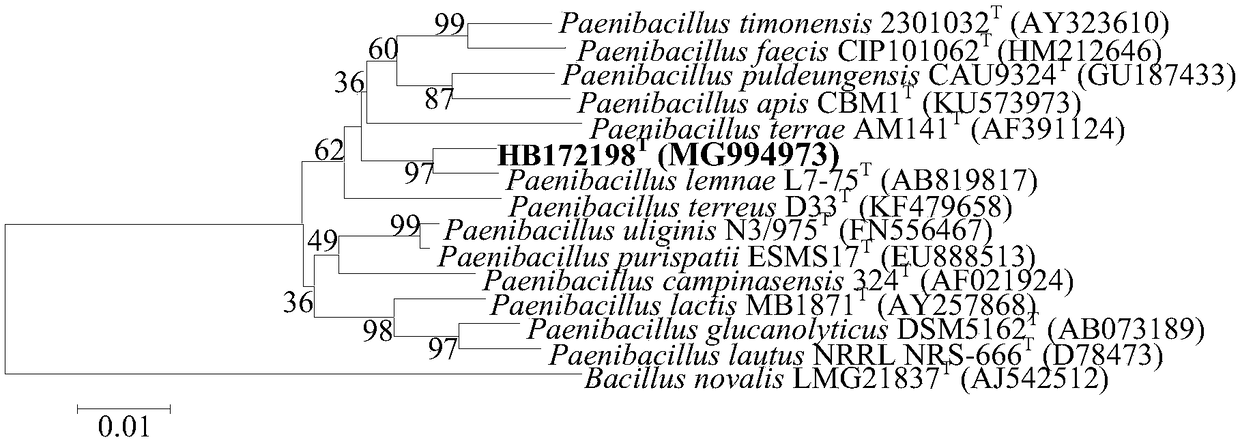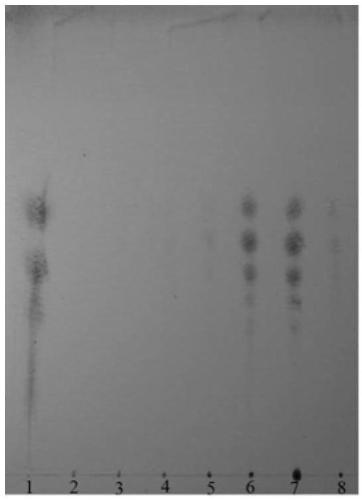Paenibacillus sp. strain HB172198 and applications thereof
A HB172198, Paenibacillus technology, applied in the field of microorganisms, can solve the problem of less Bacillus, and achieve the effect of mature technology
- Summary
- Abstract
- Description
- Claims
- Application Information
AI Technical Summary
Problems solved by technology
Method used
Image
Examples
Embodiment 1
[0030] Example 1 Isolation and Screening of Paenibacillus HB172198 CGMCC No.15412
[0031] Brown algae samples were collected in the coastal waters of Qishui Bay, Wenchang City, Hainan Province. Take 10g sample, cut it into pieces under aseptic condition, dissolve the slurry, put it in a 250mL Erlenmeyer flask filled with 90mL sterile water and glass beads, shake it in a constant temperature shaker at 28°C and 200r / min for 30min, and let it stand After 5 minutes, the supernatant was taken for 10-fold serial dilution, and diluted to 10 -1 ~10 -3 series of suspensions. Use 80°C water bath for 20 minutes to kill non-spore-forming bacteria, draw 0.1mL of the series suspension, spread it on the alginate lyase separation medium, place it in a 30°C incubator and incubate it upside down for 2-5 days.
[0032] When the colonies grow out, according to the phenotypic characteristics of the colony shape, color, edge state, transparency, surface dry and wet state, etc., pick the colonie...
Embodiment 2
[0040] Example 2 Identification of the species of Paenibacillus HB172198 CGMCC No.15412
[0041] Strain HB172198 CGMCC No.15412 was streak cultured on 2216E agar medium for 3 days, the colony was round, with regular edges, matte, flat, light yellow, opaque; the bacteria were rod-shaped, spore-forming, with flagella at both ends ( figure 1 ). Gram staining is variable, nitrates are not reduced, gelatin is not hydrolyzed, and indoles are not produced.
[0042]The 16S rDNA sequence 1477bp of HB172198 was obtained by PCR amplification and sequencing, and its nucleotide sequence is shown in SEQ ID No.1. Comparing the sequence with the sequence in the EzBioCloud database, it was found that the strain HB172198 and Paenibacillus lemnae L7-75 T The homology is the highest (97.6%), and the homology with other strains is all below 97.0%. Select related strains with high homology, and use the software MEGA5.0 to construct a phylogenetic tree using the Neighbor-joining method ( figur...
Embodiment 3
[0046] Embodiment 3 alginate lyase and preparation method thereof
[0047] The alginate lyase in the present invention is produced by fermentation of Paenibacillus HB172198 with the preservation number CGMCC No.15412 in Example 1, and the specific method includes the following steps:
[0048] (1) Bacterial strain activation: Inoculate the Paenibacillus HB172198 in Example 1 on a solid medium, and culture it at 30° C. for 48 hours to obtain an activated bacterial strain;
[0049] (2) Liquid culture: insert the activated bacterial strain into the liquid seed medium, shake and culture at 30°C and 180r / min for 12-24 hours, and make the seed liquid;
[0050] (3) Fermentation culture: Inoculate the seed liquid at 3% by volume in the liquid fermentation medium, culture at 30°C and 180r / min for 36 hours with shaking, collect the fermentation liquid, centrifuge, and collect the supernatant to obtain alginate cracking Enzyme Crude Enzyme Solution.
[0051] The solid medium in step (1)...
PUM
 Login to View More
Login to View More Abstract
Description
Claims
Application Information
 Login to View More
Login to View More - R&D Engineer
- R&D Manager
- IP Professional
- Industry Leading Data Capabilities
- Powerful AI technology
- Patent DNA Extraction
Browse by: Latest US Patents, China's latest patents, Technical Efficacy Thesaurus, Application Domain, Technology Topic, Popular Technical Reports.
© 2024 PatSnap. All rights reserved.Legal|Privacy policy|Modern Slavery Act Transparency Statement|Sitemap|About US| Contact US: help@patsnap.com










